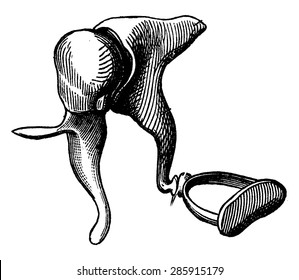what does rectus mean?
straight

The name of this group of bones.
Ossicles.
the spiral organ is also called what?
organ of corti
What is the purpose of vitreous humor?
to hold the retina in place against the choroid
what is the function of the auricle?
collect, amplify and direct sound waves into the external auditory canal.
How many rectus muscles does the eye have?
four
the tympanic membrane is commonly referred to as?
eardrum
what does the organ of coti do?
converts vibrations into nerve impulses
what does the retina do?
converts light sensations into nerve impulses

These ring-like structures on the left side of the image are partly responsible for our sense of equilibrium.
Semicircular canals.
how many oblique muscles does the eye have?
two
what are the main components of the middle ear?
tympanic membrane, auditory tube, auditory ossicles
what type of hair cells does the organ of corti have?
inner hair cells and outer hair cells
The technical term for our "blind spot".
Optic disc.
What two parts of the inner ear are associated with equilibrium?
Semicircular ducts and Vestibule
This muscle contracts in response to bright light.
Radial muscle(s) of the iris.
The auditory tube is also referred to as what?
eustachian or pharyngotympanic tube
What are the the two membranes of the organ of corti?
basilar membrane and tectorial membrane
what are the two types of photoreceptors in the eye?
rods and cones
What is organ of hearing?
cochlea
how many extrinsic muscles does the eye have?
six
What three bones make up the auditory ossicles?
Malleus, Incus, Stapes
The name of the "hairs" that bend to facilitate hearing and equilibrium.
Stereocilia.
what does the ciliary body produce?
aqueous humor
What is the passage that leads through the temporal bone to the tympanic membrane?
auditory canal